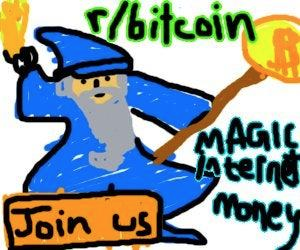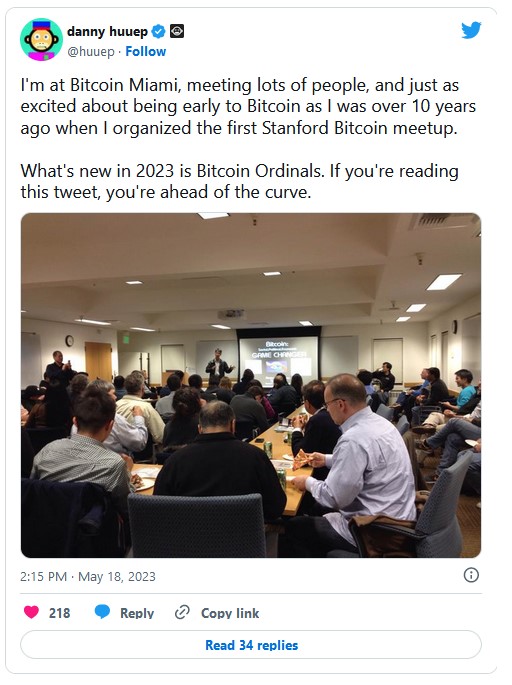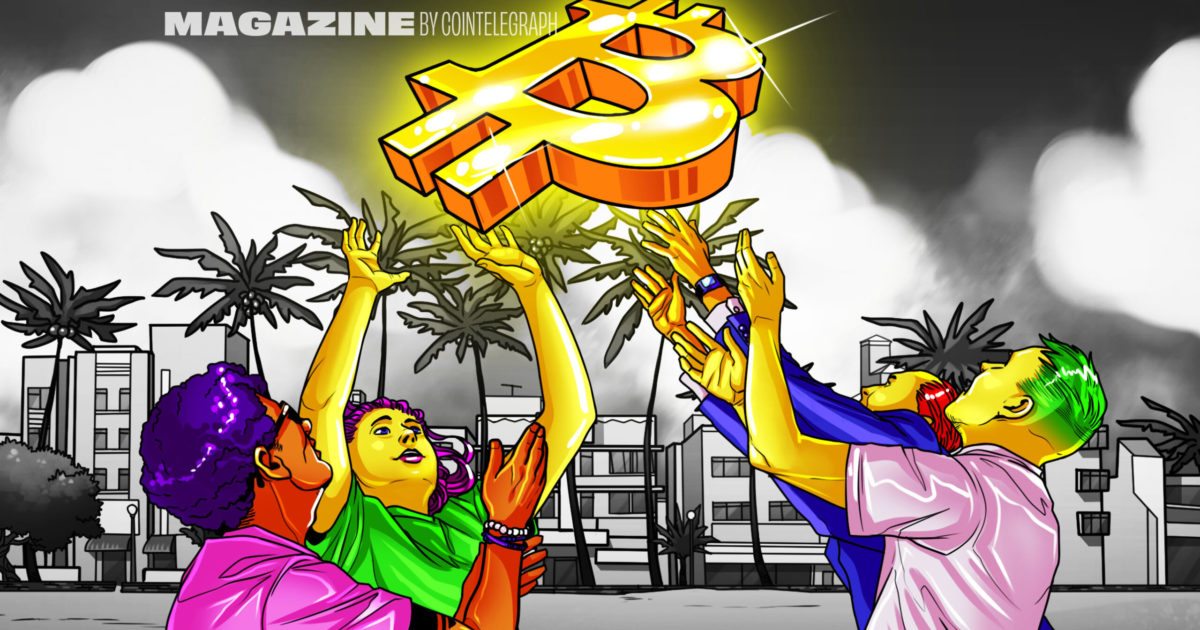Among the more memorable displays at Bitcoin 2023 is a real-life toilet with the logos of various non-Bitcoin cryptocurrencies. It’s an ad for a booth selling “buttwipes” that are “moistened with the tears of no-coiners.” The marketing message is clear: Bitcoin is the real thing — everything else is a shitcoin that belongs in the toilet.
But only a few steps away is another booth selling trading solutions for BRC-20 tokens, which some have labeled shitcoins for Bitcoin. Across the walkway are more booths slinging NFT minting software — also on Bitcoin. The conference even hosts a Bitcoin NFT art gallery.
As Miami hosts the largest Bitcoin conference for the third year in a row in May, the air feels markedly different. Though there are only 15,000 attendees compared to last year’s 35,000, the atmosphere has an energy and freshness that’s a world away from the gloom and bear-market blues that one might expect after the massive drops from the 2021 highs.
What’s changed this year is the ordinal renaissance, brought on by the recent reality of not only NFTs but tokens being issued on the Bitcoin blockchain. There are certainly haters — with some calling for a fork to undo the Taproot updates that made “spam” possible on the chain.
But despite the Bitcoin community’s traditional hatred for NFTs, tokens and DeFi, however, things are surprisingly quiet. Despite the blowback online, almost no one Magazine encounters at Bitcoin 2023 has anything particularly bad to say about Ordinals — and some did not even realize they are related to Bitcoin.
Among old-school Bitcoiners — in circles where the cryptocurrency that starts with “E” can barely be mentioned without drawing comments of derision regarding “monkey pictures” and scam coins — the Ordinal NFT phenomenon is decisively met with a quiet acceptance or shrug. Most old-timers aren’t interested but appear to accept that this is what the “young people” want today — that Bitcoin needs to change with the times.
Are Bitcoiners quietly accepting a new era where the network takes on a radically new role in the Web3 ecosystem, or is this the calm before the Bitcoin purist storm?
Bitcoin Ordinals: A new era
With the exception of the Lightning Network, which made fast and cheap Bitcoin payments possible so as to make mass payment feasible, the Bitcoin ecosystem has been relatively unchanging over the years from an outside perspective.
Mining, halvings every four years, the 21 million supply, hardware storage — beyond these core concepts, Bitcoin has lacked a certain dynamism that has placed it largely outside of the more colorful Web3 space of competing protocols, smart contracts, ICOs, NFTs, DAOs, stablecoins and myriad different tokens.
Indeed, the Bitcoin community has so ardently held on to its core tenets — rejecting new iterations, interpretations and innovations — that it is unironically considered by some as a religion, and semi-ironically as such by multitudes more.
But is a reformation — or even renaissance — in the works?

A stroll through Bitcoin 2023 — the world’s largest Bitcoin conference held in May in Miami — suggests so. This is because in addition to the yearly fare of booths related to mining, physical art, exchanges, wallet solutions and various hardware, a new entrant is out in force: NFTs.
Well, no — not NFTs. Bitcoiners call them “Ordinals.”
The word “ordinal” simply means a number used to put things in order: 5th, 6th, 7th, etc. Due to the November 2021 Taproot Bitcoin upgrade, individual satoshis, the smallest unit of Bitcoin, can now be individually numbered and thus made permanently identifiable.
Uniquely numbered satoshis — Ordinals — are nonfungible, meaning that they can no longer be substituted for another. Being (1) nonfungible and (2) tokens, they are NFTs by definition.
In Miami, perhaps the most visible landmark to this new phenomenon is Ordinal Alley, “the very first art gallery dedicated to Ordinal inscriptions” where various Bitcoin NFTs can be viewed.

Subhan Syed, co-founder of YourFund Coin, tells Magazine that “Ordinal art — whether a JPEG or MP3 — may seem irrelevant today, but as time goes on, collectors will look towards unique pieces that have truly been immortalized on the blockchain.”
The system is new and experimental, with Syed explaining that “the way inscription works today might be completely different a few years from now,” adding that it’s feasible that one day, there might not be enough satoshis to fill everyone’s inscribing needs.
“We might need a more robust solution in the long term that does not carry a load on the blockchain timestamp.”
Read also
NFTs and shitcoins — Now on BTC
In March 2023, an anonymous developer named “domo” introduced the BRC-20 system, which uses Ordinals to enable users to mint and transfer tokens on Bitcoin, in a simplistic take on Ethereum’s ERC-20 standard.

According to BRC-20.io, at one point, the market cap exceeded $1 billion, although after the initial hype died down, the 187 tracked tokens fell to half a billion, and in the midst of the SEC-derived bear market, they’re worth around $132 million with a daily volume around $47 million (although the site is offline at the time of writing).
While the conference has several booths related to Ordinals — mainly services for minting or “inscribing” them — few openly promote BRC-20 tokens beyond offering functionality to hold or trade them. While Ordinal NFT images appear to have become accepted by the mainstream Bitcoin community, it appears that BRC-20 tokens — viewed by many as shitcoins on Bitcoin — have not yet received quite the same level of acceptance.

It will be interesting to see how this changes next year when the conference moves to Nashville.
Wizards vs. laser-eyes
At a talk titled “The Great Ordinal Debate,” Bitcoin experts Udi Wertheimer and Eric Wall appeared in Taproot Wizard costumes as they made a dancing entrance. The Ordinals project celebrates the Magic Internet Money meme from the early Bitcoin days and welcomes the return of innovations being built on top of the protocol.

Certain Bitcoin maximalists hate them and the “spam” of Ordinals, believing it undermines the true purpose of Bitcoin.
Wertheimer reported that “friends reached out and implored me to reconsider going to Bitcoin Miami, due to many public violent threats” from “laser eye podcasters” who believe NFTs have no place in the Bitcoin community.
The rift that Ordinals has caused in the Bitcoin community may well be summed as a conflict between the wizards and the laser-eyes — the former representing the experimental and fun-loving early ethos of Bitcoin, while the latter conveys intensity, seriousness and an unyielding focus on their vision for the greatest form of money known to man.

After the conference, I connect with Logan Golema, who is firmly on the wizard side and has deployed a BRC-20 token for his project Galaxer, which is building a “space-based AR capture-the-flag” game to work on Apple’s Vision Pro artificial reality goggles.
Believing that Bitcoin and its Ordinals will exist “for eons” into humanity’s future, he argues that “Ordinals — whether art or money — will be important much further into the future than the deployer today may intend.”

While some in the laser-eyes camp have raised the possibility of a fork to roll back the Taproot upgrade that enables Ordinals, Golema thinks it’s unlikely. Recalling the block-size wars that were a key driver in the Bitcoin Cash fork led by “Bitcoin Jesus” Roger Ver, Golema explains that while disagreement certainly exists, “it would take a lot for a chain fork to happen” again.
Although various ways to remove what some core developers consider “spam” have been discussed, Golema believes the innovations will be broadly accepted and integrated — even if only begrudgingly because doing away with them may bring even more trouble.

But Ordinals come with benefits, too, says Golema, helping to ensure Bitcoin’s transaction fees can sustain the network after the block reward halves away to nothing in the future.
“We’ve seen for one of the first times that the fee reward was bigger than the block reward — that’s very important for the future of Bitcoin’s security.”
For Bitcoin miners, the new age means more BTC coming into their collective coffers because the minting, deploying and transfer of Ordinals and Bitcoin-based tokens all require paying miners fees. This could help solve the issue of what happens when there’s no more BTC left to mine. “Direct mining rewards will end in the year 2140, so fees will be all that’s left to incentivize miners,” Golema notes.

Similar benefits may exist for BTC hodlers — the long-term Bitcoin faithful. It is easy to imagine that as Bitcoin gains Ethereum-like capabilities, it will gain market share in NFTs and tokens, which will translate to demand not only in absolute terms but relative to competitors.
Perhaps by bringing NFTs and tokens to Bitcoin, the wizards can even prevent the flippening, the potential ascent of Etereum to the top market cap position, which until now has been theorized to happen one day as a result of Bitcoin falling behind technologically while Ethereum innovates.

Bitcoin dominance is a metric that shows the relative values of various cryptocurrencies and is followed by many Bitcoiners. Starting the year at 40%, BTC has climbed to 48.1% of the market as of writing. Can JPEGs push Bitcoin back into the 60% range and herald a new bull market?
The Ordinals wizards
Some Bitcoiners are starting to rationalize Ordinals into their worldviews.
According to Aravind Sathyanandham, chief strategy officer at Bitcoin DeFi platform Velar, the Ordinals community is markedly different from the primarily Ethereum “ape” community, which has a bad reputation among the Bitcoin crowd.
“These are Bitcoin guys — these are people who had to figure out how to run an entire node to ‘inscribe’ stuff on Bitcoin, the mother chain.”
He is referring to a kind of do-it-yourself hardiness — a rugged individualism emblematic of the money and tech conservatism of older stereotypical Bitcoiners as opposed to the also -stereotypical imagining of a more communal, liberal and younger Ethereum community.
From this Bitcoiner perspective, Ethereum is viewed as little more than a sandbox for children, while Bitcoin is eternal. Ethereum, Sathyanandham says, is a “great experiment for NFTs and DeFi to take their first form,” and now it’s Bitcoin’s turn.
“These Bitcoin wizards understood early on that the block space on Bitcoin is prime real estate — it’s forever immutable and censorship-resistant data,” he adds, not forgetting to add that Ethereum is “semi-centralized.”

The phenomenon also appears to be growing the Bitcoin user base.
“Ordinals have on-boarded so many individuals onto Bitcoin — new Bitcoin wallets like Hiro and Xverse that are akin to MetaMask have made it simple,” Sathyanandham explains, referring to the wider ecosystem being built entirely for Ordinals that mirrors Ethereum’s in many ways. He notes that “the Ethereum NFT community’s bleeding into the Bitcoin community is very evident on Crypto Twitter.”
While Syed agrees with Ordinalist exceptionalism, he sees them more as technologists than strict Bitcoiners. “I’ve seen that BRC-20 and Ordinals early adopters are individuals who are slightly more tech-savvy digital collectible fans — it’s not like some virtual flood gates opened up to bring in loads of Bitcoin maxis,” he observes.
Syed notes that “currently it’s the same people who collect ETH, Solana or BNB digital collectibles jumping in early. Early adopters always win and the bottom line is: We are all early.”
“When the next bull run comes, perhaps correlated with the BTC halving, we might see everyone rush over the BRC-20 and Ordinal narrative.”
It certainly feels like magic internet money once again.
Subscribe
The most engaging reads in blockchain. Delivered once a
week.







